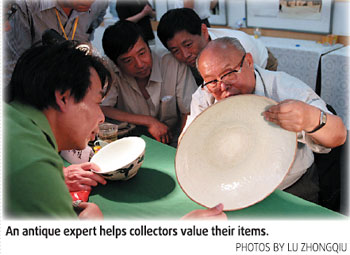Collector Zhang Liang carried his precious pot to get it valued at an event held on May 18 at the Xiannong Altar. But when he got there he was told that his collection - the pot he thought was a Han Dynasty (206 BC-220AD) relic, was actually fake. "I saw how it was dug out by a farmer near a tomb of Han Dynasty," said 30-year-old Zhang.
He was upset after the expert, Ye Du, examined the pot under a special light and told him that it was a conterfeit.
"It's fake, although its appearance looks so similar to an old piece," Ye explained. He showed the pot owner that even the taints on the smooth surface were made by modern chemical preparation.
Ye was one of the eight experts from Capital Museum invited by the Beijing Municipal Administration of Culture Relics, reappraising antiques for citizens in a free event during the May 18 International Museum Day.
Inside the room, some collectors are excited, some depressed; Outside, many gathered in the compound waiting for the appraisal of their collections. The eight experts were busy, so busy in fact that they had no time for lunch.
Ye said that antique markets are not tightly regulated and warned collectors to be cautious of traps. Besides judging porcelain by its patterns and figures, a buyer also need to pay attention to items with dust, strong smell, and broken parts.
Collector Zhang was not alone. Over 80 percent of the antiques brought by collectors turned out to be reproductions, said Xie Qiuhong, deputy director of Xiannong Altar, which is also called the Ancient Furniture Museum.
"It is very expensive for experts to appraise antiques in the market, so we want to provide an opportunity for common antique enthusiasts to talk with experts face to face," Xie said. The charge for each evaluation was only 20 yuan.
Some 95 percent of antiques preserved over several generations are real, according to Xie, and some people at the evaluation were surprised by the value of their pieces. An old man opened a red archaic box before expert Xue Jie, and revealed an ancient Chinese painting. "This painting was drawn by Emperor Yongzheng in the Qing Dynasty (1644-1911)!" said the excited expert after watching it closely. "There are eight such paintings that matched eight poems. Do you have the other seven?"
The old man replied that this painting was bought by his grandfather from Liulichang market in the early 20th century, and he was told that some of the paintings have already bought by a Korean.
Still, while Xue estimated the painting to be worth 20,000 yuan, the old man said that he would not sell it
Ao Yuan, a middle-aged woman brought a bracelet passed down by her grandmother, and listened to the expert's explanation carefully. She believed that the jewelry dated back to the Spring and Autumn Period (770-476BC), but was told that it was actually made during the Tang Dynasty (AD618-907). "It's not enough to read guide books, it is very useful to talk with experienced experts to enrich your knowledge," said Ao.
Learning to determine the value of antiques takes time, said Zhao Hongyan, a student majoring in antique appraisal and preservation at a vocational school. So far, of the universities, only Archaeology Department of Peking University offer classes on this subject. Consequently, there are few young experts in this field to meet the demand. "In the classes, teachers show lots of antiques from different dynasties to appreciate, and introduce modern techniques of making reproductions," said Zhao.
"To get a basic understanding of porcelain from the Yuan Dynasty (1271-1368), you need to do several years research."
(China Daily 05/30/2007 page4)